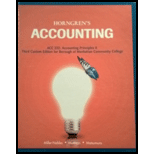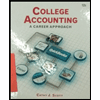
Concept explainers
Using the sales, cash receipts, and general journals
Assume Smiling Springs Glass Company uses the perpetual inventory system general ledger of Smiling Springs Glass Company includes the following selected counts, along with their account numbers:
16 Office Supplies 51 Cost of Goods Sold
18 Equipment
| Number | Account | Number | Account |
| 11 | Cash | 19 | Land |
| 12 | 41 | Sales Revenue | |
| 13 | Notes Receivable | 42 | Sales Discounts |
| 15 | Merchandise Inventory | 43 | Sales Returns and |
All credit sales are on Smiling Spring’s standard terms of 2/10, n/30. Sales and cash receipts transactions in July were as follows:
Jul. 2 Sold merchandise inventory on credit to Intelysis, Inc., $1,700. Smiling Spring’s cost of these goods was $200.
3 As an accommodation to a competitor, sold office supplies at cost, $60, receiving cash.
7 cash sales for the week totaled $2,000 (cost, $1,500).
9 Sold merchandise inventory on account to A. B Moore, $7,500 (cost, $5,400)
10 Sold land that cost $8,000 for cash of the same amount
11 Sold merchandise inventory on account to Smart Electric, $5,800 (cost, $3,250)
12 Received cash from Intelysis in full settlement of its account receivable from July 2.
14 Cash sales for the week were $2,500 (cost, $1,700).
15 Sold merchandise inventory on credit to the
18 Received merchandise inventory sold on July 9 to A. B. Moore for $300. The goods sh pped were unsatisfactory. These goods cost Smiling Springs $200.
20 Sold merchandise inventory on account to Smart Electric, $650 (cost, $350).
21 Cash sales for the week were $900 (cost, $650).
22 Received $4,000 cash from A. B. Moore in partial settlement of his account receivable. There was no discount.
25 Received cash from West & Bob for its account receivable from July 15.
25 Sola merchandise inventory on account to Oggie Co., $1,590 (cost, $960).
27 Collected $5,600 on a note receivable. There was no interest earned.
28 Cash sales for the week totaled $3,790 (cost, $2,460).
29 Sold merchandise inventory on account to R. O. Bankston, $200 (cost, $120).
30 Received merchandise inventory sold on July 25 to Oggie Co. for $40. The cost of these goods was $10.
31 Received $3,200 cash on account from A. B. Moore.
Requirements
1. Use the appropriate journal to record the preceding transactions in a sales journal (omit the Invoice No. column), a cash receipts journal, and a general journal. Smiling Springs Glass Company records sales returns and allowances in the general journal.
2. Total each column of the sales journal and the cash receipts journal. Show that total debits equal total credits.
3. Show how postings would be made by writing the account numbers and check marks in the appropriate places in the journals.
Want to see the full answer?
Check out a sample textbook solution
Chapter 7 Solutions
ACCOUNTING PRINCIPLES 222 5/16 >C<
- Which is not an objective of internal controls?A. Safeguard assetsB. Improve profitsC. Ensure accurate recordsD. Promote operational efficiency no aiarrow_forwardPlease provide the accurate answer to this financial accounting problem using appropriate methods.arrow_forwardI am searching for the accurate solution to this financial accounting problem with the right approach.arrow_forward
- 20 Nelson and Murdock, a law firm, sells $8,000,000 of four-year, 8% bonds priced to yield 6.6%. The bonds are dated January 1, 2026, but due to some regulatory hurdles are not issued until March 1, 2026. Interest is payable on January 1 and July 1 each year. The bonds sell for $8,388,175 plus accrued interest. In mid-June, Nelson and Murdock earns an unusually large fee of $11,000,000 for one of its cases. They use part of the proceeds to buy back the bonds in the open market on July 1, 2026 after the interest payment has been made. Nelson and Murdock pays a total of $8,456,234 to reacquire the bonds and retires them. Required1. The issuance of the bonds—assume that Nelson and Murdock has adopted a policy of crediting interest expense for the accrued interest on the date of sale.2. Payment of interest and related amortization on July 1, 2026.3. Reacquisition and retirement of the bonds.arrow_forward13 Which of the following is correct about the difference between basic earnings per share (EPS) and diluted earnings per share? Question 13 options: Basic EPS uses comprehensive income in its calculation, whereas diluted EPS does not. Basic EPS is not a required disclosure, whereas diluted EPS is required disclosure. Basic EPS uses total common shares outstanding, whereas diluted EPS uses the weighted-average number of common shares. Basic EPS is not adjusted for the potential dilutive effects of complex financial structures, whereas diluted EPS is adjusted.arrow_forwardPlease explain the solution to this general accounting problem with accurate explanations.arrow_forward
- I need guidance with this financial accounting problem using the right financial principles.arrow_forwardGeneral Accounting Question Solutionarrow_forwardWhich is not an objective of internal controls?A. Safeguard assetsB. Improve profitsC. Ensure accurate recordsD. Promote operational efficiencyarrow_forward
 College Accounting (Book Only): A Career ApproachAccountingISBN:9781337280570Author:Scott, Cathy J.Publisher:South-Western College Pub
College Accounting (Book Only): A Career ApproachAccountingISBN:9781337280570Author:Scott, Cathy J.Publisher:South-Western College Pub College Accounting (Book Only): A Career ApproachAccountingISBN:9781305084087Author:Cathy J. ScottPublisher:Cengage LearningPrinciples of Accounting Volume 1AccountingISBN:9781947172685Author:OpenStaxPublisher:OpenStax College
College Accounting (Book Only): A Career ApproachAccountingISBN:9781305084087Author:Cathy J. ScottPublisher:Cengage LearningPrinciples of Accounting Volume 1AccountingISBN:9781947172685Author:OpenStaxPublisher:OpenStax College College Accounting, Chapters 1-27AccountingISBN:9781337794756Author:HEINTZ, James A.Publisher:Cengage Learning,
College Accounting, Chapters 1-27AccountingISBN:9781337794756Author:HEINTZ, James A.Publisher:Cengage Learning, Cornerstones of Financial AccountingAccountingISBN:9781337690881Author:Jay Rich, Jeff JonesPublisher:Cengage Learning
Cornerstones of Financial AccountingAccountingISBN:9781337690881Author:Jay Rich, Jeff JonesPublisher:Cengage Learning Corporate Financial AccountingAccountingISBN:9781305653535Author:Carl Warren, James M. Reeve, Jonathan DuchacPublisher:Cengage Learning
Corporate Financial AccountingAccountingISBN:9781305653535Author:Carl Warren, James M. Reeve, Jonathan DuchacPublisher:Cengage Learning





